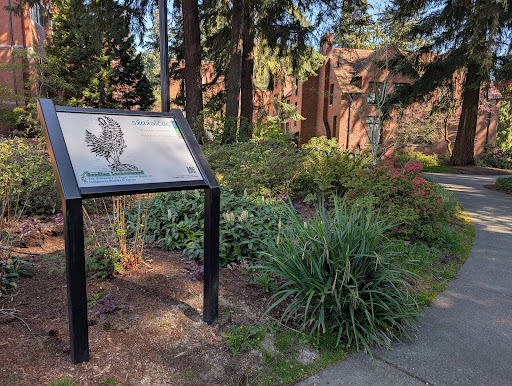
By Charlie Cronk
It has been four years since the start of the Seeding Lushootseed project, a collaboration between the University’s departments for African American studies, environmental policy and decision-making, and the Puyallup Tribal Language Program. This March, the project installed seven permanent signs labelling six different plants on campus with their original Lushootseed names.
Professor Rachel DeMotts in environmental policy and decision-making and Professor Renee Simms in African American studies partnered with the Puyallup Tribal Language Program to implement this vision, involving two years of ENVP/AFAM 301-Environmental Racism students. The signs are designed to serve as a reminder of the Puyallup stewardship over the lands that the University of Puget Sound occupies. “I’m happy that we took the time to enact an inclusive project that centered the language program’s goal of making Lushootseed more visible in Tacoma,” DeMotts said.
The permanent installations replace temporary yard signs that displayed the same information, a product of the project’s early stages. Many students wondered why it took so long for the University to make the signage permanent. “By its nature, this kind of engaged community work takes time and patience to do well,” Professor DeMotts said. “I think that meaningful work requires a thoughtful process, and speed is not reflective of that as a value.”
The project received approximately $25,000 from four different grants. In 2021, they were awarded two grants from the Civic Scholarship Initiative and the Diversity, Equity, and Inclusion funds. The permanent signs were funded in 2023 by NW5C Engage Funding from the Mellon Foundation and a 2024 ASUPS grant.
Two different classes of ENVP/AFAM 301-Environmental Racism, co-taught by DeMotts and Simms, worked on the signs. The Fall 2021 class designed them with support from print & copy services design and production specialist, Henry Waymack. Chris Briden, one of the Lushootseed language teachers for the Puyallup Tribe, translated and edited the signs. The fall of 2021 class introduced the yard signs to campus; the class in the fall of 2023 carried on the work to make the signs permanent. The fall ’23 class also researched the University’s connections to the Cushman Boarding School, and researched, wrote and proposed a new land acknowledgment for the University. “We hoped to break some of the patterns of the past, in which our institution has not been the best of partners. We sent tutors to the Cushman Boarding School, which sought to violently and systematically erase the Puyallup way of being in the world,” DeMotts said.
The ENVP/AFAM 301 class chose the western red cedar, Nootka rose, western sword fern, Oregon grape, and the Pacific rhododendron to be featured on the signs. Professor DeMotts explained they wanted to prioritize plants that are visible all year. The signs’ placement between Thompson and Wyatt was also carefully chosen. Professor DeMotts explained, “We wanted to concentrate them in one area for now as a visual illustration of being in relationship and connected, rather than spreading them all over campus.”
Taj Phillips (‘25), who took ENVP/AFAM 301 in Fall ‘23, said, “I feel proud that the signs are now implemented on campus. It is important that we recognize and respect the Indigenous people who were the original stewards of the land we are now living on.” Kolea Caverly (‘25), who was also in the class, said, “It is so important and impactful to make indigeneity visible, especially in places that have been both historically and currently violent towards it.”
“I hope that by putting the language back on this particular land that we are currently occupying, we might be able to remedy a bit of the erasure it has suffered,” DeMotts said. “I do think that this campus should be engaging in a deep and difficult accounting of its own historical and current practices that perpetuate exclusion and marginalization.”
